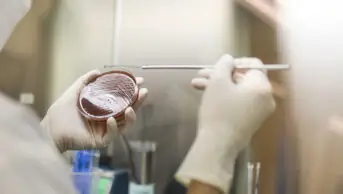
Ian Davidson Photography / Shutterstock.com
The UK government expects pharmacists who work in care homes and GP surgeries to play a greater role in tackling antimicrobial resistance (AMR), according to new proposals.
The Department of Health and Social Care’s five-year plan ‘Tackling antimicrobial resistance 2019–2024,’ says these pharmacists are a “key link” with colleagues in primary care and can review antibiotic prescribing and challenge when it is inappropriate.
Pharmacists would be expected to review the dose and duration of long-term or repeat antibiotic prescriptions and work with prescribers to review those deemed inappropriate through “evidence-based, system-wide interventions”.
The report, which updates the government’s 2013–2018 AMR strategy, published in September 2013, says: “The NHS’ increasing deployment of clinical pharmacists working in primary care, including within care homes and GP practices, offers new opportunities for enhancing antimicrobial stewardship through knowledge exchange and learning.”
The proposals, which were unveiled by health secretary Matt Hancock at the World Economic Forum in Davos, Switzerland on 24 January 2019, also include plans to introduce a new formula for paying drug companies for NHS drugs aimed to encourage them to invest in antibiotic research and development.
Currently the UK government pays drug companies according to the volume of NHS sales, but the report argues that this system disincentivises antibiotic research and development and encourages industry to over-market products, which in turn damages AMR stewardship.
The proposed system would mean linking payment to the potential “health” value of the drug.
The National Institute for Health and Care Excellence (NICE) is developing the new formula in conjunction with industry and is due to publish its proposals at the end of January 2019.
The report said: “We will test a new model that will de-link the payments made to companies from the volumes of antibiotics sold, basing the payment on a NICE-led assessment of the value of the medicines and supporting good stewardship.”
Other proposals in the plan include targets to reduce the number of drug-resistant infections by 10% or 5,000 cases by 2025, as well as to reduce antibiotic use by 15% during the same timescale.
Sandra Gidley, chair of the Royal Pharmaceutical Society English Pharmacy Board, told The Pharmaceutical Journal that the government was “missing a trick” if it failed to include community pharmacists in its AMR stewardship proposals.
She welcomed the idea behind the drug payment formula adding: “Anything which encourages research into new antibiotics is necessary but I think [the potential success of the proposal] will depend on the NICE criteria and how it defines ‘health’.
“I suspect that the development of new antibiotics is not as easy as it might seem. You just can’t bring out a variation of penicillin for example as the chances are that the bugs are resistant to it.
“So it’s about creating a new class of antibiotics and that requires a lot of investment and takes years to bring a new drug to market.”
The Association of the British Pharmaceutical Industry confirmed it has been working with the government on a new payment formula for the past two years.


